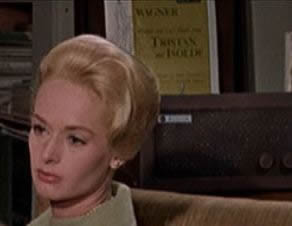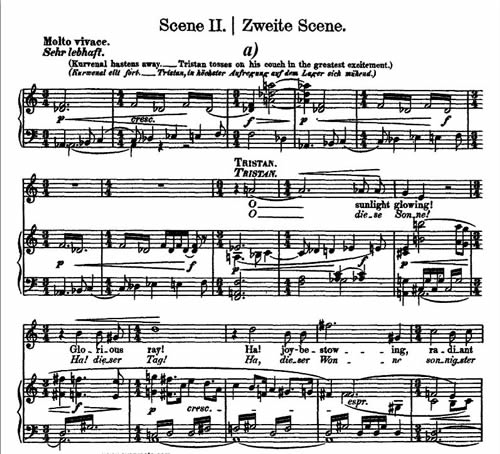Melanie's Coercion by the Birds
Wagner, Masculinity, and Annie

In the scene in Annie's house in which the two women discuss their problems with men, no diegetic music is present per se, but it could be argued that a piece of the mis-en-scene, which figures prominently into many of the shots, serves a function comparable to that of diegetic music. Throughout the scene, a record of Wagner's "music drama" Tristan und Isolde can be seen behind the heads of Melanie and Annie. The record's presence, although subtle, casts a whole new light on the gender coding of the scene. Most oviously, the storyline of the opera emphasizes the tragic outcome of Annie's sexual encounters with Mitch and foreshadows the hopelessness of her situation and, ultimately, her death. Tristan und Isolde centers around two lovers who can never be together and both ending dying by the work's close. The piece most commonly attributed to Tristan und Isolde is the Liebestod. The association with this piece, however, provides only cursory meaning to this prop.
 [17]
[17]
Upon closer inspection another relevant and meaningful conclusion can be drawn. If one commutes the scene to include O Diese Sonne from Tristan, the whole scene takes on a much more masculine vibe. In a study conducted among undergraduates at Stanford in 1951, Wagner was ranked as the most "masculine" composer from a list of twenty. [12] The masculinity of Wagner's "music dramas" can be attributed to the growing presence of brass instruments and extensive use of the male voice in many of his works. Wagner experimented heavily with the use of brass instruments, especially with the trombone and the tube. He also was one of the first composers to use the male voice in showcase form rather than as an effect to support the female voice. [13] Interestingly, Wagner, himself, believed that opera could be divided into masculine and feminine parts. The feminine part was the music itself, while the masculine part was the text.[14] Since Annie only has the album on display and does not play the actual music, the viewer can only read what symbolizes the text of the opera. This isolates the "masculine," which becomes the only part of the opera associated with Annie. Not only does Annie appear to enjoy a very "masculine" composer but she only associates herself with the masculine aspect of his work.